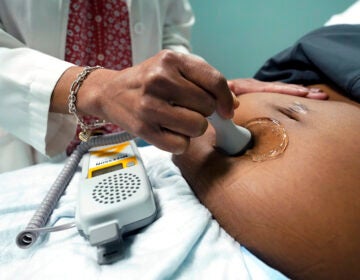How hospitals can tackle the maternal mortality crisis

A change in hospital culture can help prevent serious complications and death during delivery, according to clinicians who work in the field. (Ian Hoot/Science Photo Library/Getty Images)
Having a baby in the United States can be dangerous. American women are more likely than women in any other developed country to die during childbirth or from pregnancy-related complications. And while other countries’ maternal death rates have gone down, U.S. rates have risen since 2000, a fact that has left both doctors and expectant mothers concerned about the state of maternity care in this country.
But many of these problems could be prevented if hospitals would standardize the way they care for women in labor, according to the authors of a recent essay in the New England Journal of Medicine. They say hospitals can improve quality of care for three common complications in childbirth: heavy bleeding after delivery known as postpartum hemorrhage, problems with high blood pressure, and blood clots before or after delivery.
If hospitals check every single patient for these conditions, the authors say, and use research-backed protocols to treat them, obstetricians can help fight the high rate of maternal deaths, which they call a national “tragedy.”
NPR talked with on of the authors, Dr. Kimberlee McKay, who teaches obstetrics and gynecology at the University of South Dakota and oversees obstetrics for Avera Health, a network of hospitals that includes several rural maternity services. She talked about lessons learned working in smaller, rural health care systems — which often lack the resources to recognize and treat problems common in childbirth — and how these apply to hospitals everywhere.
This interview has been edited for clarity and length.
What made you interested in working to improve systems of obstetric care?
I came out of residency in the mid-2000s. I don’t think we were as smart about how we took care of patients. I started looking for ways to say, How do you take really good care of patients and not have it feel so stressful?
I went around to all of our facilities and started asking the question: “What keeps you up at 2 am when you’re taking care of pregnant patients?” Let me tell you, that gave us a tremendous amount of information to start our work.
What kind of stories did you hear?
In Pierre, S.D., they sit right in the middle of the state. When they need platelets, [used when a patient has a significant blood loss], they call Rapid City, S.D., and the highway patrol drives from Pierre, and then someone with platelets drives from Rapid City Regional [Hospital]. They meet halfway, and then they drive it down the interstate.
That sounds very challenging. Bigger hospitals have a lot more resources.
[My co-author Dr. Susan Mann] likes to say, ‘We sneeze and someone hands us a Kleenex.’ That’s not how it is in a critical access hospital. How they manage their resources is frankly genius.
It is extremely important that we continue to keep these smaller places open. The quality of your care should not be determined by where you live. Period.
How is that even some large, well-resourced hospitals might not be prepared for common complications during delivery?
Failure to recognize is a big problem, not just in obstetrics but in medicine in general. What we’ve worked really hard on in my own system is to really shore up the recognition piece. We do drills. We have education teams. It really takes a commitment to that. It takes hospital administrators saying, “You know what? We’re going to give our staff time. We’re going to pay them to go in and do these education sessions.”
How could a doctor or midwife not recognize a common problem like a postpartum hemorrhage?

In the old days, we would say, you can’t diagnose a postpartum hemorrhage until it’s a postpartum hemorrhage. We would kind of wait for the blood loss to accumulate and hope that they got better.
Now they say, “Don’t wait.” So when we notice when blood loss is heavier, we immediately start looking for things to correct that bleeding. We start taking frequent vital signs. We may be getting blood from the blood bank.
What about high blood pressure during delivery? How could an obstetrician miss that?
When you’re in the heat of the moment, and I, as a delivering physician, notice that the blood pressure is elevated, the first thing I think of is, “Well, it’s not accurate because she’s pushing.” Nobody is doing anything particularly wrong. When you’re pushing a baby out, that’s such a critical stage in terms of making the baby is safe and not being harmed. A blood pressure cuff goes off in the middle of that, you may not notice it.
What kind of changes could help fix this?
When you notice a change in the patient’s status, you need to communicate it to the team. Then you make a plan, and everyone is held accountable to the plan. It seems really like, “Well, duh, why wouldn’t you do it that way?” But in practice, medicine is a very complicated system.
What is it about a maternity ward that might make it hard for a team to communicate clearly?
Back in the 1960s, when my husband’s granddaddy was a country doctor in Florida, it was a different problem because there was such a hierarchy. I really feel like medicine isn’t at that place anymore. You’ve got a nurse who’s documenting minute by minute in the delivery suite. You’ve got a nurse who’s receiving the baby. We have a scrub tech, a physician, a resident. We’re all interacting with the technology and the patient.
And if you don’t take a moment to talk about a change in the patient’s status, in all of that chaos, it gets lost. There’s just a lot of noise in medicine right now. And distraction.
What should expectant moms ask their doctors or midwives about before they deliver? How can they make sure their care team is prepared?
Patients, for years, have brought in their birth plan: “This is what I desire.” That’s always shared decision making with your physician and your care team and your midwife. The flip side is [asking]: “If everything doesn’t go well, what have you done to prepare for an emergency? What has your facility done to prepare?”
You ought to be able to have a good conversation with your physician. And we don’t get that. We get more of, “I don’t want any intervention.” It’s scary to think about, right? When I work with my patients, we talk about why that intervention [may be] important, and what the data has shown.
What’s been holding the health care community back from doing more to improve in this area?
It takes not just the desire of the people providing the care … to do a better job. It takes the commitment of the administration to say we’re going to invest in this. A huge piece of this investment is taking a really hard look at your culture. It’s time, it’s cost, and it’s a great deal of dedication. You’ve just kind of got to hunker down and do it.
Mara Gordon is a family physician in Washington, D.C., and a health and media fellow at NPR and Georgetown University School of Medicine.
9(MDAzMzI1ODY3MDEyMzkzOTE3NjIxNDg3MQ001))




